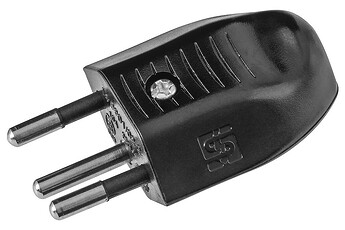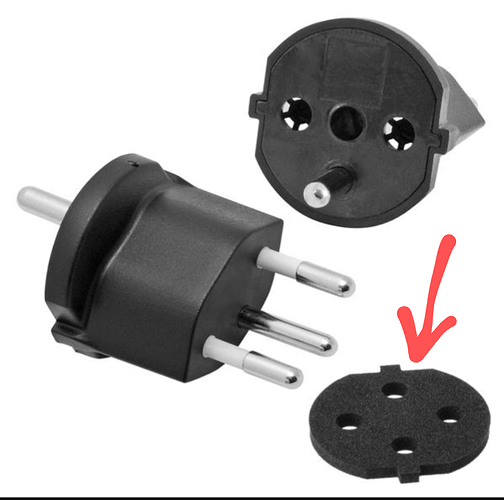Not that old, actually.![]() I was going to say that this was in the 1980s, but a quick search tells me that in fact UK regulations requiring fitted moulded plugs only came into force in 1994. Not sure about other EU countries but would expect it to be around the same time.
I was going to say that this was in the 1980s, but a quick search tells me that in fact UK regulations requiring fitted moulded plugs only came into force in 1994. Not sure about other EU countries but would expect it to be around the same time.
I had some British plugs on British bought devices. After moving back here, we cut the plug off and put Swiss ones on.
I moved here in ‘85 and remember some electrics coming without plug attached. Usually they included a Swiss and a French one with instruction on how to attach them. I definitely recall a kettle coming like this.
omg!
I’ve never heard of this before; it certainly wasn’t the case in my socialist birth country in the 1980s (and my parents never mentioned it either).
Did you ask Galaxus to send you an adapter? Based on what I read in reviews many times, they send an adapter for free.
Appliances without plugs was the norm in the UK when I was growing up, in fact moulded plugs attached to appliances was only really becoming the norm when we left the UK in 1989.
Every Brit over the age of about 40 will know how to wire a plug as we were all taught it at school.
Having said that we had far fewer electrical appliances back then and they were built to last so people didn’t buy new ones very often.
Yep that’s what we’ve always got from Galaxus too.
It’s the adapters they give in Gifi if you buy something from there which are rather bulky.
They sent it for free. I had no idea when I ordered what the plug was.
The only issue is if the manufacturer wants to be an arse they could argue that you’ve just voided the warranty. Not an issue for a CHF 20 hairdryer but it would be for a CHF 3000 Miele combination oven. So those clip on adaptors are the best choice.
Indeed. I dropped the plug of my kitchen mixer to the floor and it cracked a bit. Replaced it with one of these:
Cut the big sheath with 3 cables inside. Remove ~5mm of the sheath from smaller 3 cables, insert cables in the holes designed for them, tighten the screws, tighten the final screw of the plug cover. End.
As Ace mentioned, it’s less than 2 CHF https://www.jumbo.ch/de/maschinen-werkstatt/elektro-material/kabel-stecker-schalter/stecker-kupplungen/steko-mount-stecker-t12--schwarz/p/5615068
No I didn’t. I had a spare one lying with me.
Naah, I don’t believe could they void the warranty for fitting a different plug.
Common sense would dictate that, but if they want to be difficult they could argue that you’ve tampered with the device e.g. Liebherr T&C.
The Liebherr Switzerland guarantee expires if, regardless of who did this, the type plate or the device number has been removed, tampered with or made illegible, or if parts of foreign origin have been installed in the device.
Swiss consumer law limits protection to the use of a non-removable plug adaptor. You can imagine a scenario where someone mixes up the live, earth and neutral wires, damages the device and then tries and claim warranty. Even if they were to hastily re-wire it correctly, they wouldn’t have a leg to stand on.
Why is it a problem if you use a removable adaptor?
BTW, do you think it’s bad if I forgot to put the small part shown on the picture between a plug and an adapter on my new microwave? I only noticed it after I connected an adaptor and I cannot remove it anymore.
Good question.
I would like to read that part of Swiss consumer law.
Electrical appliances sold in Switzerland need to have a plug conforming to Swiss standard SEV 1011. Schuko stands for the German term «Schutz-Kontakt» and refers to a system of plugs and sockets that is mainly used in Europe. Large parts of Europe use a two-pin plug. These plugs, as in the example picture below, don’t fit the sockets in Switzerland. The law allows using permanent adapters, which – once attached to the plug – can’t be removed.
Source
Its derived from
- The Ordinance on Low Voltage Electrical Equipment (NEV, SR 734.26) requires compliance with Swiss safety standards.
- The Swiss plug standard (SN SEV 1011) covers the design of plugs in detail.
IN the device.
Nope. It would be practically impossible to damage a device this way. Circuit breakers would trip immediately, way before any damage could be done. (Or fuses on really old installations)
Because they’re too big, a single one in a typical 3-way Swiss socket blocks both of the other sockets, same on aftermarket extension leads and power strips.
To be clear, I’ve rewired all my EU purchased devices because I agree. However the most expensive is a €100 Tefal sandwich toaster so I’ll take my chances.
It doesn’t explain why the non-removable adapters are required by law. Half of wall sockets in my house are single sockets, so the size of adapter doesn’t matter.
I banged it into chatgpt and it spat out the following.
Appliances that do not have a Swiss plug must have a proper, permanent adapter meeting Swiss requirements—travel adapters are viewed as temporary and are not acceptable for permanent use under Swiss safety rules. A permanent (often called “fixed”) adapter cannot simply slip off or get dislodged, which reduces the risk of electric shock or poor contact. Swiss regulations consider that kind of risk mitigation essential for anything that’s sold or installed for everyday home or office use.
I think they would just prefer you bought a Swiss wired appliance from a bricks and mortar store as opposed to a grey import from Galaxus or whatever. So the whole adaptor thing is a begrudging acceptance, albeit with the caveat that its a fixed as opposed to temporary solution and the Swiss retailer should provide it.

